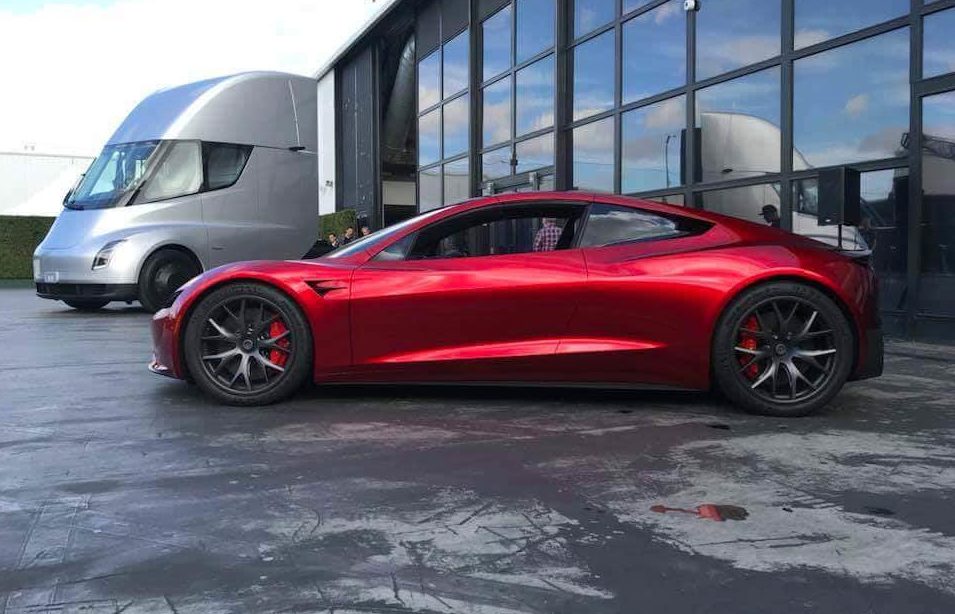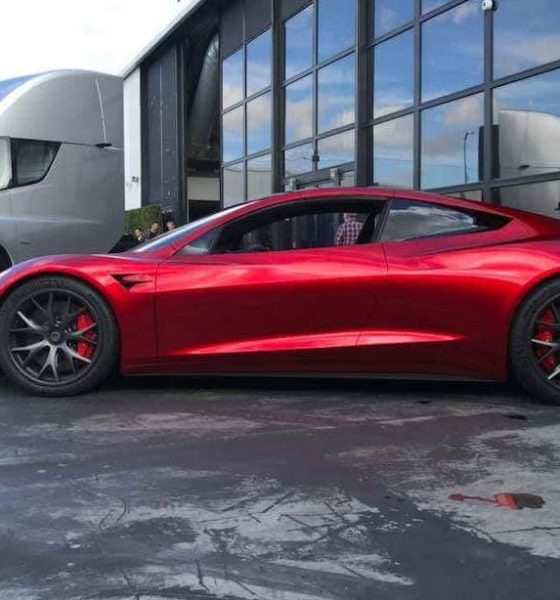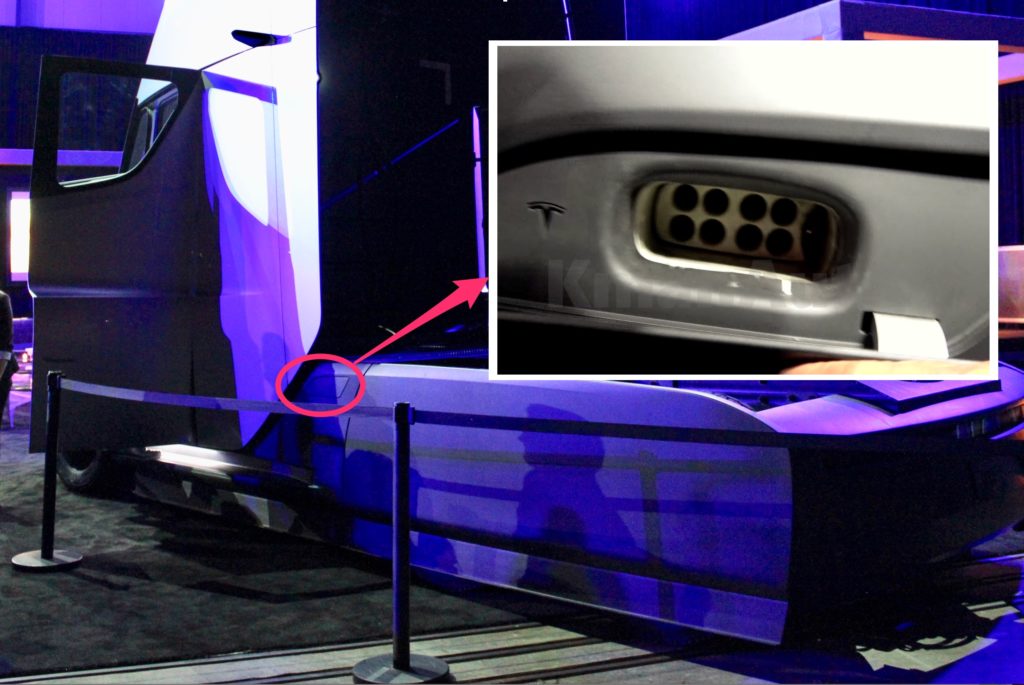

News
Tesla Semi and Roadster could be relying on a “battery breakthrough”
Elon Musk and Tesla have made some bold claims for the new Tesla Semi and Roadster. Those who understand batteries have been scratching their heads trying to figure out how the company can deliver the specs it’s promising – and concluding that the only possible way is some as-yet-unannounced advancement in battery technology.
Musk says the Tesla Semi will be able to haul 80,000 pounds for 500 miles, and recharge to 400 miles in 30 minutes, which would revolutionize the trucking industry. As for the Roadster, its promised 0-60 acceleration of 1.9 seconds effectively shuts down every one of the world’s baddest supercars, and its touted 620-mile range would be double that of any EV produced to date.
However, industry experts are questioning Tesla CEO Elon Musk’s touted range and charging capabilities, saying the specifications defy current physics and battery economics.
According to Bloomberg, analysts at Bloomberg New Energy Finance point out that Tesla Semi’s announced specs would require a battery capacity of between 600 and 1,000 kilowatt hours (6-10 times the size of the largest Model S battery). Using current technology, an 800 kWh battery pack would weigh over 10,000 pounds and cost more than $100,000. That’s just for the battery – Tesla has said its entire truck will start at $150,000. It seems plain that Tesla is counting on falling battery prices to square the circle. “The first Tesla Semis won’t hit the road until late 2019,” Bloomberg points out. “Even then, production would probably start slowly. Most fleet operators will want to test the trucks before considering going all-in. By the time Tesla gets large orders, batteries should cost considerably less.”
It isn’t just the capacity of the battery that’s causing analysts to wear out their calculators – Musk’s claim that the Tesla Semi will be able to add 400 miles of charge in 30 minutes would require a charging system 10 times more powerful than Tesla’s current Supercharger – which is already by far the most powerful in the industry.

Tesla Semi Megacharger port could support 1 MW of power.
“I don’t understand how that works,” said Bloomberg New Energy Finance EV Analyst Salim Morsy. “I really don’t.” Tesla’s current generation of Superchargers have a power output of 120 kilowatts and can add about 180 miles of range to a Model S battery in 30 minutes. To meet Tesla’s charging claim for the Semi would require the promised Megacharger to deliver an output of at least 1,200 kW.
Perhaps Tesla’s biggest bombshell is the promise that it will guarantee truckers electricity rates of 7 cents per kilowatt hour, which Bloomberg estimates could translate to fuel savings of up to $30,000 a year. Musk says that adding solar panels and battery packs at the charging stations will account for at least part of the cost reduction. However, BNEF’s Salim Morsy insists that Tesla will have to heavily subsidize those electricity rates – he estimates that Tesla will pay a minimum of 40 cents per kWh. “There’s no way you can reconcile 7 cents a kilowatt hour with anything on the grid that puts a megawatt hour of energy into a battery,” Morsy said. “That simply does not exist.”
Of course, that’s no different from what Tesla does for its current Supercharger network, offering free electricity to many customers, while paying almost $1 per kWh to produce it, according to Morsy’s estimate.
And how about that Roadster? To deliver its promised range of 620 miles, it will need a 200 kWh battery pack, twice the size of Tesla’s largest currently available pack. Mr. Morsy predicts that Tesla will stack two battery packs, one on top of the other, beneath the Roadster’s floor.
Even with a double-decker pack however, it’s hard to escape the conclusion that Tesla is counting on improving battery tech to make the Roadster, like the Semi, feasible. Battery density has been improving at a rate of about 7.5 percent a year, and that’s without any major breakthrough in battery chemistry.
“The trend in battery density is, I think, central to any claim Tesla made about both the Roadster and the Semi,” Morsy said. “That’s totally fair. The assumptions on a pack in 2020 shouldn’t be the same ones you use today.”
A massive battery pack not only enables greater range – it’s also a key element in the Roadster’s world-beating 0-60 acceleration. Jalopnik’s David Tracy spoke with battery expert Venkat Viswanathan, a Mechanical Engineering Assistant Professor at Carnegie Mellon, who says that the 1.9-second figure actually seems reasonable.
Viswanathan explains that the power output of a motor is limited by the power draw from each battery cell. Because the Roadster’s pack is double the size, the power draw may not be that much more than that of a Ludicrous Model S.
Viswanathan told Jalopnik that the most modern battery cells offer specific energy of about 240 watt-hours per kilogram. Using that assumption, the Roadster’s 200 kWh battery pack should weigh roughly 1,800 pounds, a huge advance over the previous-generation Roadster. With clever use of lightweight materials, the Roadster could still come out under the nearly two-ton curb weight of the Nissan GT-R, an acceleration benchmark among sports cars.
Viswanathan concludes that a 0-60 time of 1.9 seconds and a range of 620 miles are quite feasible, although there are several other factors that will come into play – much depends on the vehicle’s tires and aerodynamics.
Meanwhile, at least one analyst thinks Tesla’s latest revelations (or claims, or fantasies, depending on your point of view) have implications that go far beyond the Semi and the Roadster. Michael Kramer, a Fund Manager with Mott Capital Management, told Marketwatch that he suspects improved battery capacities and charging times could make their way into all future Tesla vehicles.
“I’d have to imagine that Tesla has figured out how to put this technology on all of their cars, which means every car could get a full charge in under 30 minutes,” Kramer wrote. Once the Model S “is equipped with the 200 kWh battery pack in the new Roadster, which I can’t imagine is too far down the road, the range issue for the Tesla is officially dead.” (Elon Musk has said that Models S and X will not get physically larger packs, but improved energy density could increase capacity while keeping the size of the pack the same.) Someday soon, Kramer says, “The Model S would likely be able to drive further on one charge than a car on a full tank of gasoline.”
===
Note: Article originally published on evannex.com, by Charles Morris

News
Tesla starts showing how FSD will change lives in Europe
Local officials tested the system on narrow country roads and were impressed by FSD’s smooth, human-like driving, with some calling the service a game-changer for everyday life in areas that are far from urban centers.

Tesla has launched Europe’s first public shuttle service using Full Self-Driving (Supervised) in the rural Eifelkreis Bitburg-Prüm region of Germany, demonstrating how the technology can restore independence and mobility for people who struggle with limited transport options.
Local officials tested the system on narrow country roads and were impressed by FSD’s smooth, human-like driving, with some calling the service a game-changer for everyday life in areas that are far from urban centers.
Officials see real impact on rural residents
Arzfeld Mayor Johannes Kuhl and District Administrator Andreas Kruppert personally tested the Tesla shuttle service. This allowed them to see just how well FSD navigated winding lanes and rural roads confidently. Kruppert said, “Autonomous driving sounds like science fiction to many, but we simply see here that it works totally well in rural regions too.” Kuhl, for his part, also noted that FSD “feels like a very experienced driver.”
The pilot complements the area’s “Citizen Bus” program, which provides on-demand rides for elderly residents who can no longer drive themselves. Tesla Europe shared a video of a demonstration of the service, highlighting how FSD gives people their freedom back, even in places where public transport is not as prevalent.
What the Ministry for Economic Affairs and Transport says
Rhineland-Palatinate’s Minister Daniela Schmitt supported the project, praising the collaboration that made this “first of its kind in Europe” possible. As per the ministry, the rural rollout for the service shows FSD’s potential beyond major cities, and it delivers tangible benefits like grocery runs, doctor visits, and social connections for isolated residents.
“Reliable and flexible mobility is especially vital in rural areas. With the launch of a shuttle service using self-driving vehicles (FSD supervised) by Tesla in the Eifelkreis Bitburg-Prüm, an innovative pilot project is now getting underway that complements local community bus services. It is the first project of its kind in Europe.
“The result is a real gain for rural mobility: greater accessibility, more flexibility and tangible benefits for everyday life. A strong signal for innovation, cooperation and future-oriented mobility beyond urban centers,” the ministry wrote in a LinkedIn post.
News
Tesla China quietly posts Robotaxi-related job listing
Tesla China is currently seeking a Low Voltage Electrical Engineer to work on circuit board design for the company’s autonomous vehicles.

Tesla has posted a new job listing in Shanghai explicitly tied to its Robotaxi program, fueling speculation that the company is preparing to launch its dedicated autonomous ride-hailing service in China.
As noted in the listing, Tesla China is currently seeking a Low Voltage Electrical Engineer to work on circuit board design for the company’s autonomous vehicles.
Robotaxi-specific role
The listing, which was shared on social media platform X by industry watcher @tslaming, suggested that Tesla China is looking to fill the role urgently. The job listing itself specifically mentions that the person hired for the role will be working on the Low Voltage Hardware team, which would design the circuit boards that would serve as the nervous system of the Robotaxi.
Key tasks for the role, as indicated in the job listing, include collaboration with PCB layout, firmware, mechanical, program management, and validation teams, among other responsibilities. The role is based in Shanghai.
China Robotaxi launch
China represents a massive potential market for robotaxis, with its dense urban centers and supportive policies in select cities. Tesla has limited permission to roll out FSD in the country, though despite this, its vehicles have been hailed as among the best in the market when it comes to autonomous features. So far, at least, it appears that China supports Tesla’s FSD and Robotaxi rollout.
This was hinted at in November, when Tesla brought the Cybercab to the 8th China International Import Expo (CIIE) in Shanghai, marking the first time that the autonomous two-seater was brought to the Asia-Pacific region. The vehicle, despite not having a release date in China, received a significant amount of interest among the event’s attendees.
Elon Musk
Elon Musk and Tesla AI Director share insights after empty driver seat Robotaxi rides
The executives’ unoccupied tests hint at the rapid progress of Tesla’s unsupervised Robotaxi efforts.

Tesla CEO Elon Musk and AI Director Ashok Elluswamy celebrated Christmas Eve by sharing personal experiences with Robotaxi vehicles that had no safety monitor or occupant in the driver’s seat. Musk described the system’s “perfect driving” around Austin, while Elluswamy posted video from the back seat, calling it “an amazing experience.”
The executives’ unoccupied tests hint at the rapid progress of Tesla’s unsupervised Robotaxi efforts.
Elon and Ashok’s firsthand Robotaxi insights
Prior to Musk and the Tesla AI Director’s posts, sightings of unmanned Teslas navigating public roads were widely shared on social media. One such vehicle was spotted in Austin, Texas, which Elon Musk acknowleged by stating that “Testing is underway with no occupants in the car.”
Based on his Christmas Eve post, Musk seemed to have tested an unmanned Tesla himself. “A Tesla with no safety monitor in the car and me sitting in the passenger seat took me all around Austin on Sunday with perfect driving,” Musk wrote in his post.
Elluswamy responded with a 2-minute video showing himself in the rear of an unmanned Tesla. The video featured the vehicle’s empty front seats, as well as its smooth handling through real-world traffic. He captioned his video with the words, “It’s an amazing experience!”
Towards Unsupervised operations
During an xAI Hackathon earlier this month, Elon Musk mentioned that Tesla owed be removing Safety Monitors from its Robotaxis in Austin in just three weeks. “Unsupervised is pretty much solved at this point. So there will be Tesla Robotaxis operating in Austin with no one in them. Not even anyone in the passenger seat in about three weeks,” he said. Musk echoed similar estimates at the 2025 Annual Shareholder Meeting and the Q3 2025 earnings call.
Considering the insights that were posted Musk and Elluswamy, it does appear that Tesla is working hard towards operating its Robotaxis with no safety monitors. This is quite impressive considering that the service was launched just earlier this year.








